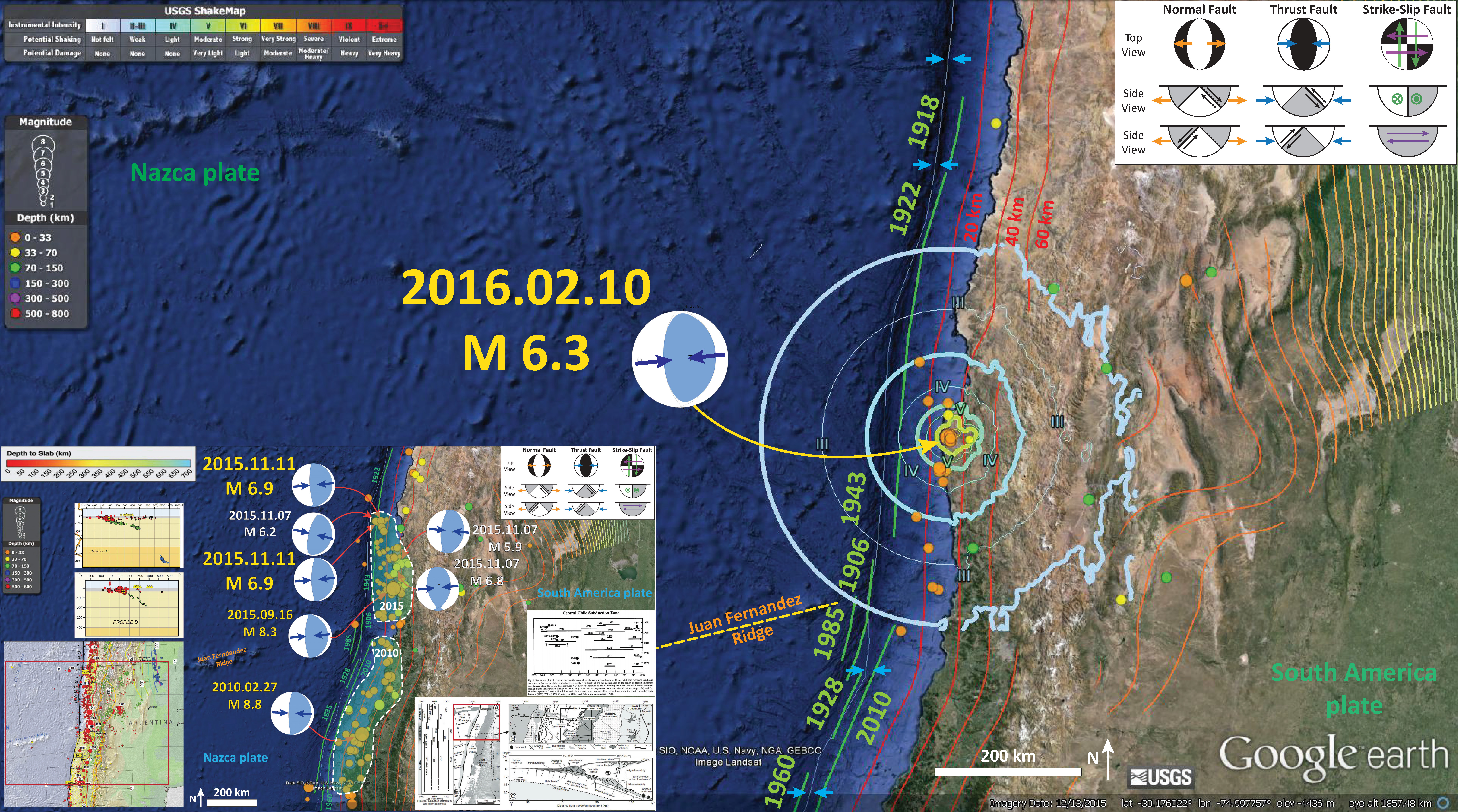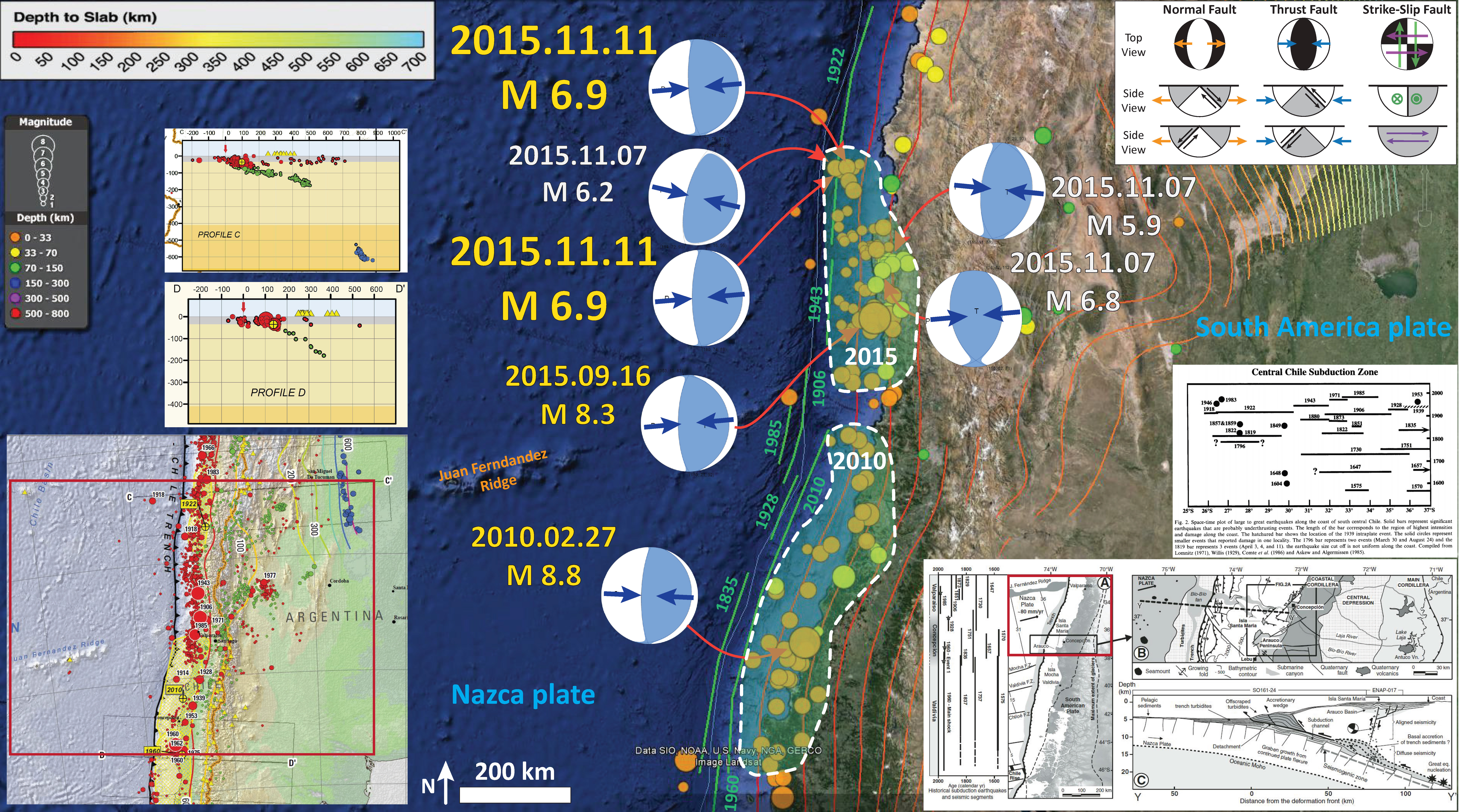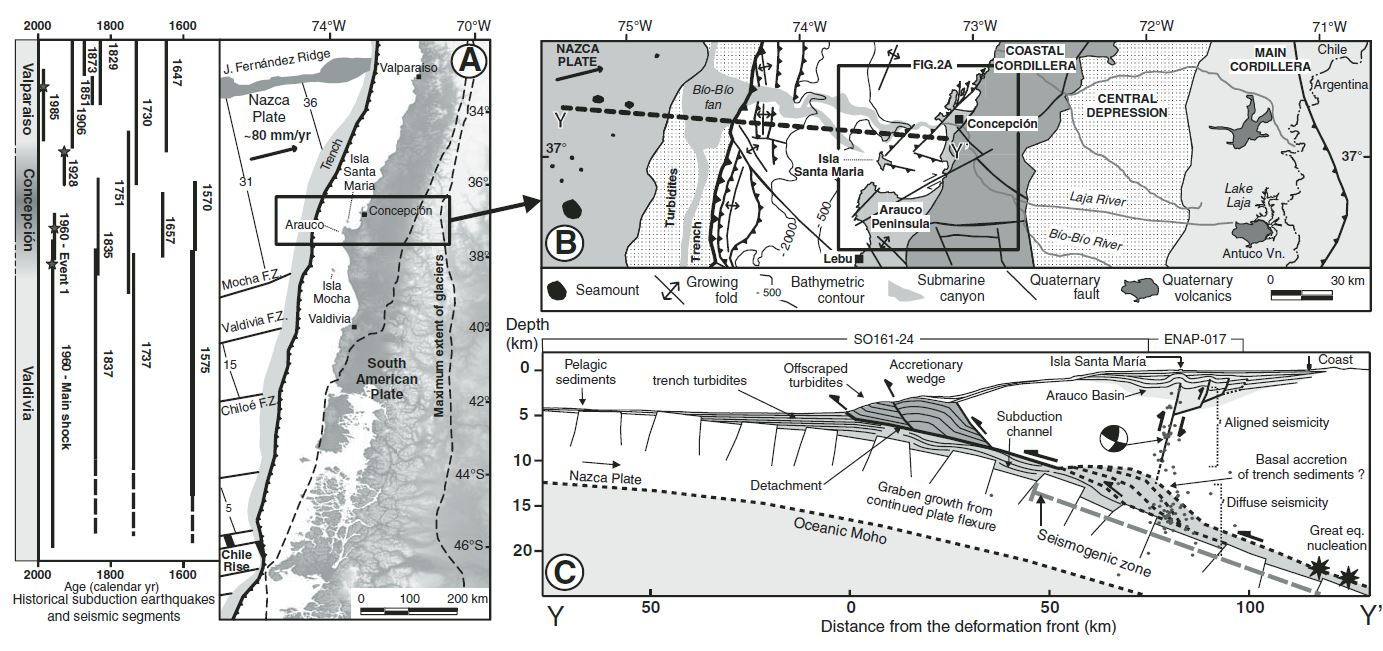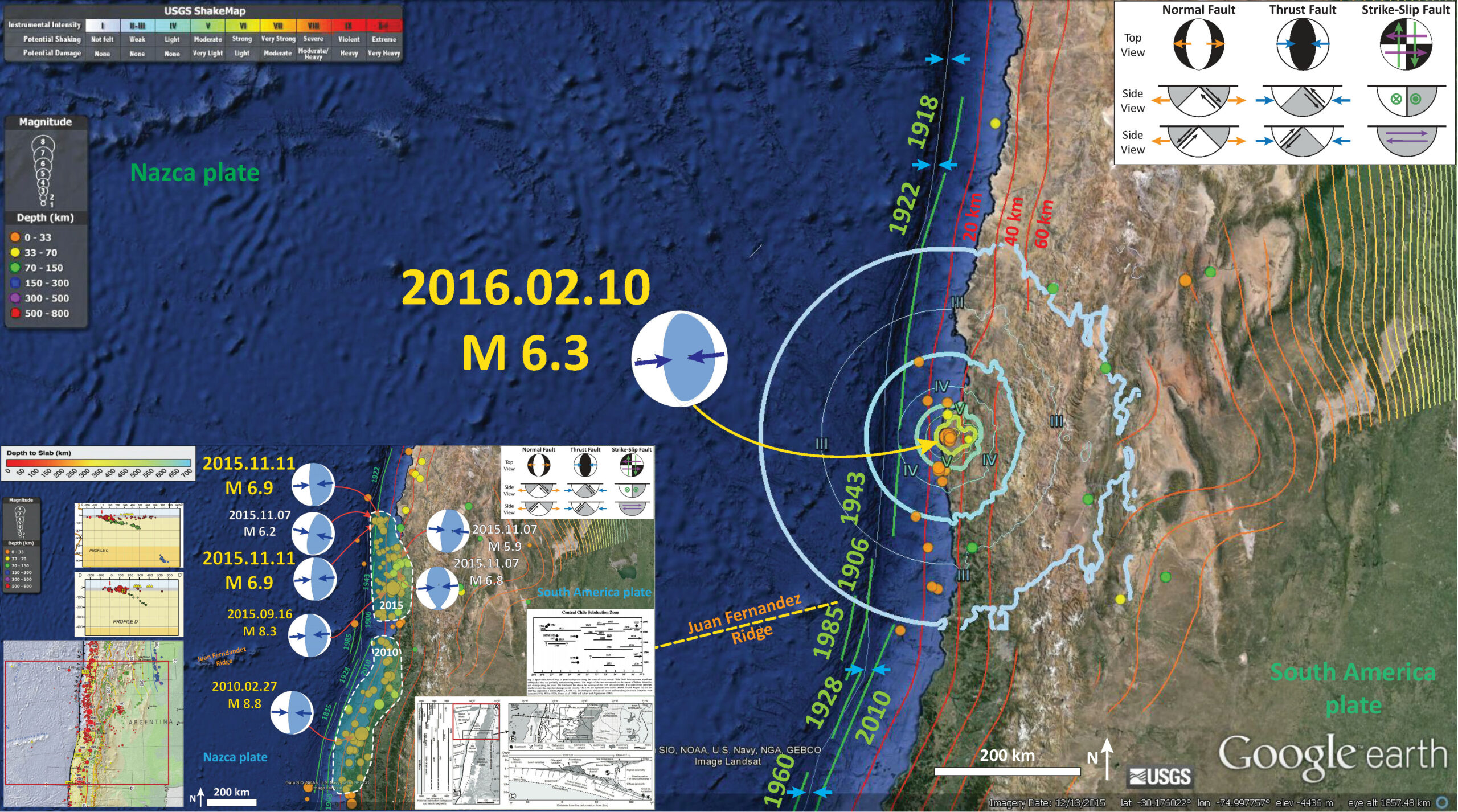The aftershocks from the 2015.09.16 M 8.3 Chile earthquake continue. Today was an earthquake with magnitude M = 6.3. Here is the USGS website for today’s earthquake. I presented a comprehensive review of Chile’s historic seismicity, as well as the seismicity from 2015, here. I also presnt a summary of the seismicity in this region from 2000-2015 here.
Below is my interpretive map for today’s earthquake. I have plotted the epicenters (using the USGS earthquake feed kml) for the past 30 days with magnitudes 2.5 or greater, with color representing depth. I also include the slab depth contours from Hayes et al. (2012). These are the depth contours for the fault interface of the subduction zone. I discuss this further in my Chile 2015 Earthquake Report. The M 6.3 earthquake has a depth of ~31.5 km, which modestly fits the slab contours (the three shallowest contours are labeled in red). I also plot the historic earthquake slip regions in green (Beck et al., 1998). I include the earthquake intensity, using the USGS Modified Mercalli Intensity Scale. The largest MMI intensity contour is VI. I plot the location of the Juan de Fernandez Ridge in yellow, which may be controling the segmentation of faulting along this subduction zone (von Huene et al., 1997).
I placed a moment tensor / focal mechanism legend in the upper right corner of the map. There is more material from the USGS web sites about moment tensors and focal mechanisms (the beach ball symbols). Both moment tensors and focal mechanisms are solutions to seismologic data that reveal two possible interpretations for fault orientation and sense of motion. One must use other information, like the regional tectonics, to interpret which of the two possibilities is more likely.

Here is the map that I include as an inset map. This map shows the extent of the 2010 and 2015 subduction zone earthquakes in Chile.

I also placed a map from the USGS earthquake summary poster in the lower left corner (Hayes et al., 2015). The red rectangle shows the general location of the main map. The USGS plot epicenters for historic earthquakes on the map, along with the slab contours (Hayes et al., 2012). There are two cross sections plotted on the map (C-C’ on the north and D-D’ on the south). The USGS plot these hypocenters along these two cross sections and I include those. The 2015 earthquake patch is just south of cross section C-C’.
In the lower right corner I place a cross section from Melnick et al. (2006). This shows the prehistoric earthquake history on the left and a cross section of the subduction zone on the right. This cross section is in the region of the 2010 subduction zone earthquake. Above the Melnick et al. (2006) figure I include the space-time diagram from Beck et al. (1998 ) showing the along strike length of prehistoric earthquakes in the central subduction zone. The map above shows these prehistoric rupture strike lengths as green lines (labeled with green labels). The 2015 earthquake series ruptured past the southern boundary of the 1943 earthquake and about 30% into the 1922 earthquake region. There is a small gap between the 2010 and 2015 earthquake series, which aligns with the Juan Fernandez Ridge (a fracture zone in the Nazca plate; von Huene et al., 1997; Rodrigo et al., 2014). This fracture zone appears to be a structural boundary to earthquake slip patches (subduction zone segmentation), at least for some earthquakes. Beck et al. (1998 ) show that possibly two earthquakes ruptured past this boundary (1730 A.D. and possibly 1647 A.D., though that is queried). This segment boundary appears to be rather persistent for the past ~500 years.
-
Here are some earthquake reports from this 2015 earthquake series:
- 2015.09.16 First Report
- 2015.09.16 First Update
- 2015.09.17 Second Update
- 2015.09.19 Third Update
- 2015.09.17 Tsunami Observations
- 2015.09.18 Historic Chile Tsunami Comparisons
- 2015.03.14 Seismicity 2000-2014
Here are some reports that include comparisons of historic seismicity of this region.
Here is the cross section of the subduction zone just to the south of this Sept/Nov 2015 swarm (Melnick et al., 2006). Below I include the text from the Melnick et al. (2006) figure caption as block text.

(A) Seismotectonic segments, rupture zones of historical subduction earthquakes, and main tectonic features of the south-central Andean convergent margin. Earthquakes were compiled from Lomnitz (1970, 2004), Kelleher (1972), Comte et al. (1986), Cifuentes (1989), Beck et al. (1998 ), and Campos et al. (2002). Nazca plate and trench are from Bangs and Cande (1997) and Tebbens and Cande (1997). Maximum extension of glaciers is from Rabassa and Clapperton (1990). F.Z.—fracture zone. (B) Regional morphotectonic units, Quaternary faults, and location of the study area. Trench and slope have been interpreted from multibeam bathymetry and seismic-reflection profiles (Reichert et al., 2002). (C) Profile of the offshore Chile margin at ~37°S, indicated by thick stippled line on the map and based on seismic-reflection profiles SO161-24 and ENAP-017. Integrated Seismological experiment in the Southern Andes (ISSA) local network seismicity (Bohm et al., 2002) is shown by dots; focal mechanism is from Bruhn (2003). Updip limit of seismogenic coupling zone from heat-fl ow measurements (Grevemeyer et al., 2003). Basal accretion of trench sediments from sandbox models (Lohrmann, 2002; Glodny et al., 2005). Convergence parameters from Somoza (1998 ).
References:
- Beck, S., Barientos, S., Kausel, E., and Reyes, M., 1998. Source Characteristics of Historic Earthquakes along the Central Chile Subduction Zone in Journal of South American Earth Sciences, v. 11, no. 2., p. 115-129.
- Hayes, G.P., Wald, D.J., and Johnson, R.L., 2012. Slab1.0: A three-dimensional model of global subduction zone geometries in, J. Geophys. Res., 117, B01302, doi:10.1029/2011JB008524
- Hayes, G.P., Smoczyk, G.M., Benz, H.M., Villaseñor, Antonio, and Furlong, K.P., 2015. Seismicity of the Earth 1900–2013, Seismotectonics of South America (Nazca Plate Region): U.S. Geological Survey Open-File Report 2015–1031–E, 1 sheet, scale 1:14,000,000, http://dx.doi.org/10.3133/ofr20151031E.
- Melnick, D., Bookhagen, B., Echtler, H.P., and Strecker, M.R., 2006. Coastal deformation and great subduction earthquakes, Isla Santa María, Chile (37°S) in GSA Bulletin, v. 118, no. 11/12, p. 1463-1480.
- Rodrigo, C. and Lara, L.E., 2014. Plate tectonics and the origin of the Juan Fernández Ridge: analysis of bathymetry and magnetic patterns in Lat. Am. J. Aquat. Res, v. 42, no. 4, p. 907-917
- von Huene, R. et al., 1997. Tectonic control of the subducting Juan Fernandez Ridge on the Andean margin near Valparaiso, Chile in Tectonics, v. 16, no. 3, p. 474-488.

2 thoughts on “Earthquake Report: Chile!”